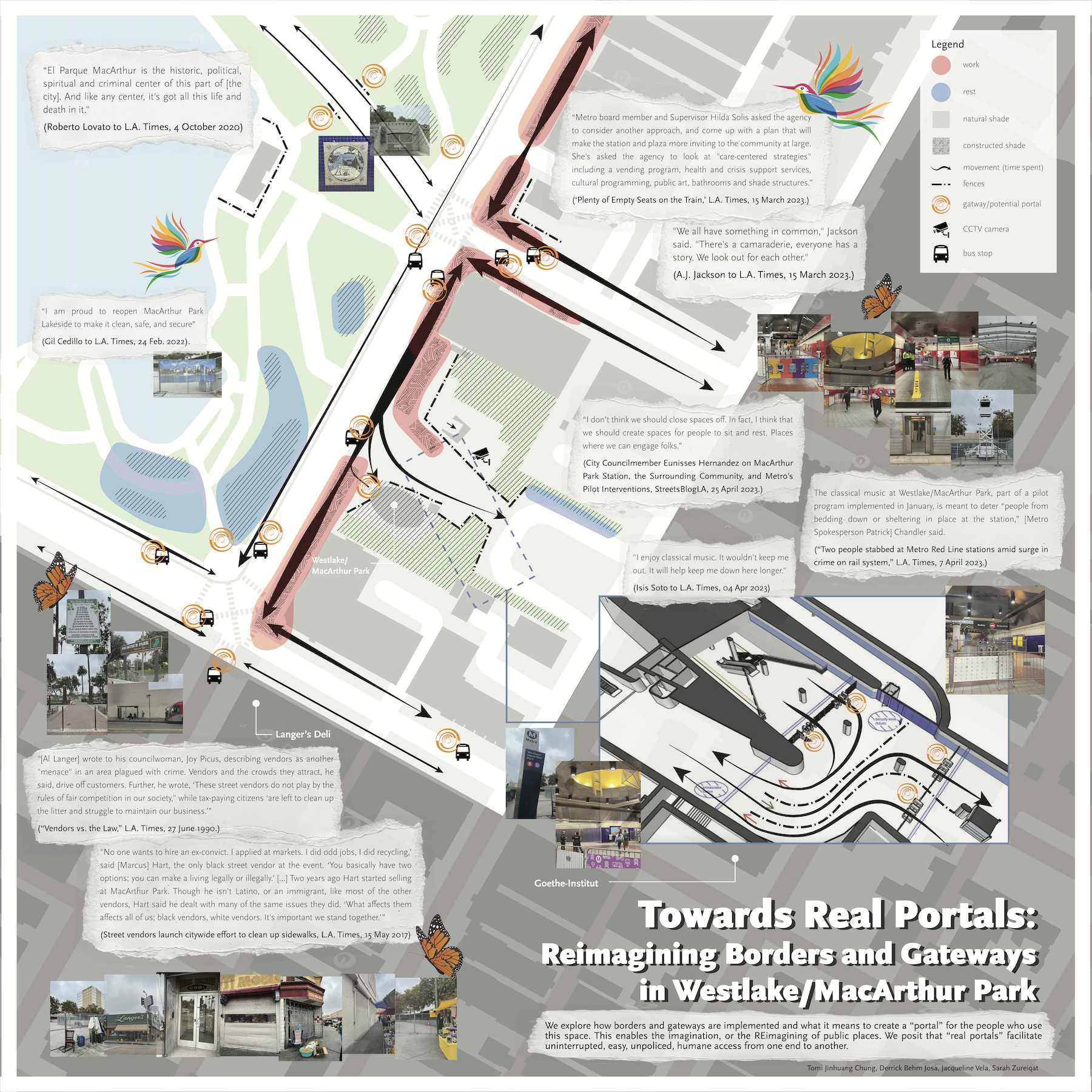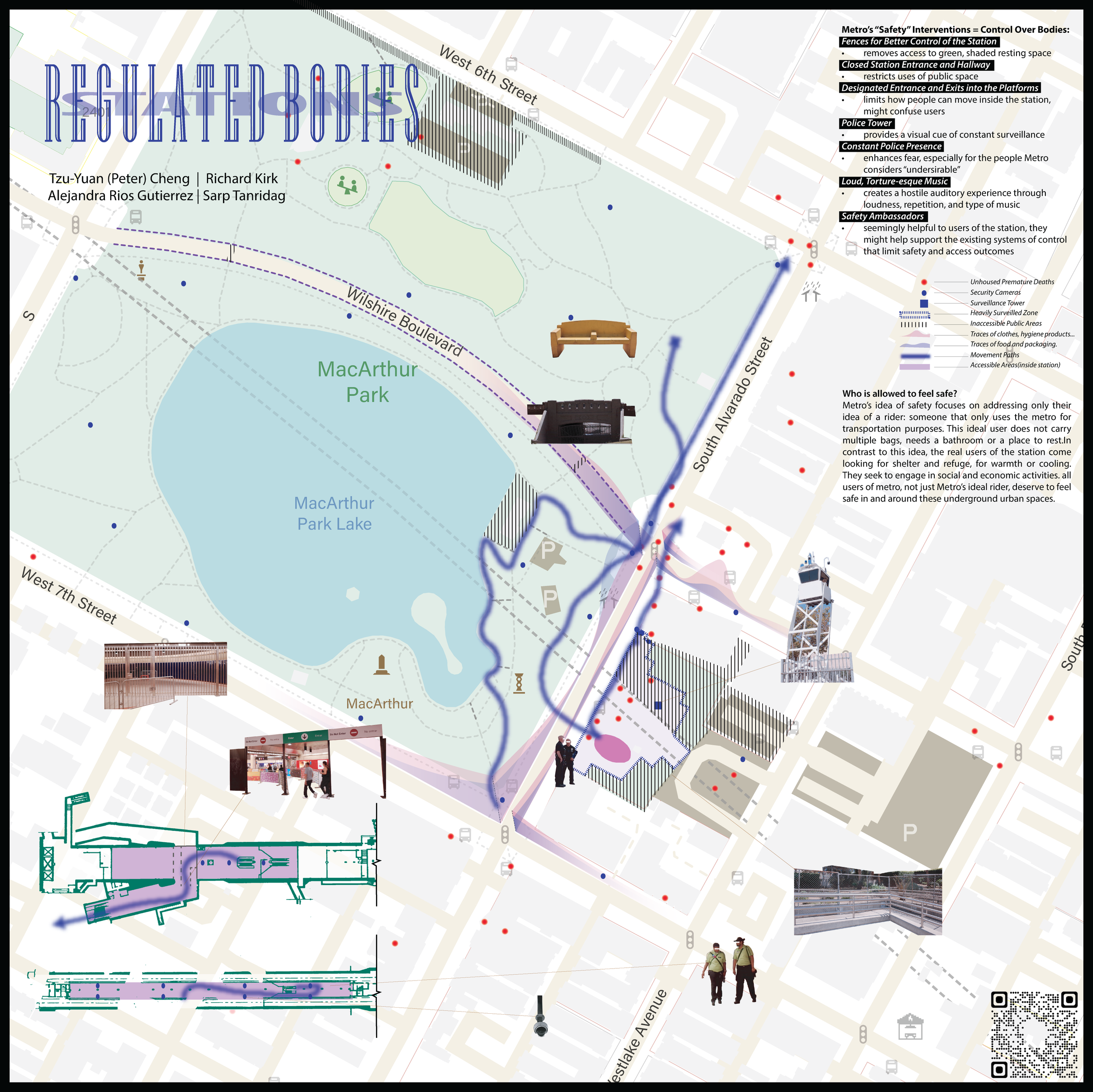Summer Institute 2023
Learning From Westlake: Mapping Spaces of Mobility, Power, and Resistance
Instructors: Gus Wendel, Claire Nelischer, Doga Tekin
Students: UHI 2023-24 Cohort
Westlake/MacArthur Park Hosts: Heart of Los Angeles (HOLA)
Students in the 2023 Summer Institute investigated the theme of Mobilities in the Westlake/MacArthur Park Neighborhood of Los Angeles. The physical infrastructures of mobility are all around us, including sidewalks, streets, and public transit systems, –urban spaces that can be hospitable or alienating, gated or accessible, vibrant or abandoned. Spaces of mobility are furnished with lighting, planting, places to rest, entryways, and signage and governed by formal and informal rules. The ability to move across borders (national, regional, localized), to access public space, and to make claims to or remain in place, is determined by power structures enshrined in enduring settler colonial logics dictated by race, gender, sexuality, class, and disability. The tools of the state, including urban planning and design, have been leveraged to both contain the movement of people and determine their status in relationship to other people, to the state, and to the space they occupy. As a result, mobility inequities are deeply ingrained in our civic institutions and spatial practices. However, such immobilities are not always easily apprehensible. A key task for the urban humanist is to both reveal and counter these forces of spatial immobilization, and to identify the potential for liberatory interventions that recognize the potency of everyday life.
Students were organized into three topic tracks under the theme of Mobilities:
1) Markings: Indigenous immigrant pockets of resistance and affirmation
2) Banqueteando: Exploring and elevating youth visions of sidewalks as public spaces
3) Stations: Everyday micro-urbanisms and transit interventions
Developed in collaboration with long-standing neighborhood partner organizations, each track was concerned with a set of issues and constituents that differently relate to the overarching theme of Mobilities. The hybrid strategies of thick mapping helped us uncover the issues behind each track, and ultimately led to the creation of a layered, multi-dimensional, and nuanced portrait of Westlake/MacArthur Park. See the students’ thick maps below.

Chapinlandia
UHI Summer Institute 2023
Students: Alexa Vaughn, Steven Carmona Mora, Senna Hanner-Zhang
A study of the 6th Street Corridor in MacArthur Park, illustrating ecologies of care created by the Indigenous Mayan community. Ecologies of care range from non-human to human: the Pink Trumpet Tree and the Coast Live Oak illustrate that native and non-native species can coexist and share habitat value for hummingbirds, other animals, and humans. The Mayan community embodies an ecology of care through local economy, art, and a shared cultural value of generosity; and extends this culture past the boundaries of the 6th Street Corridor. As we approach the work of documenting the rich histories of Indigenous immigrant communities, how can we begin to map and expand ecologies of care? How can ecologies of care physically manifest through design initiatives?

El Derecho: A No Migrar, A Retornar, A Permanecer
UHI Summer Institute 2023
Students: Nidia Bautista, Nils Jepson, Carolyn Park, Xen Pei Hoi
Our map is about the context of mobility and immobility: the right to stay, and the right to return in reference to the Mayan Corridor proposal that begins at the intersection of Alvarado St. and 6th St. till the intersection of Loma Drive. We tried to inhabit the idea of messiness and complexity as a good thing but also a troubling situation that could ruin lives, kill people, and thinking on a macro scale: wouldn’t it be great if migration became a more straightforward process? The map contextualizes the Mayan corridor as both a Monument and Memorial and is enhanced by the adjacent businesses that are grappling with the themes of Residue, and Migration.

Towards Real Portals: Reimagining Borders and Gateways in Westlake/MacArthur Park
UHI Summer Institute 2023
Students: Tomi Jinhuang Chung, Derrick Behm Josa, Jacqueline Vela, Sarah Zureiqat
We explore how borders and gateways are implemented and what it means to create a “portal” for the people who use this space. This enables the imagination, or the RE-imagining of public places. We posit that “real portals” facilitate uninterrupted, easy, unpoliced, humane access from one end to another.

Regulated Bodies
UHI Summer Institute 2023
Students: Tzu-Yuan (Peter) Cheng, Alejandra Rios Gutierrez, Richard Kirk, Sarp Tanridag
Who is allowed to feel safe? Metro’s idea of safety focuses on addressing only their idea of a rider: someone that only uses the metro for transportation purposes. This ideal user does not carry multiple bags, needs a bathroom or a place to rest. In contrast to this idea, the real users of the station come looking for shelter and refuge, for warmth or cooling. They seek to engage in social nad economic activities. All users of Metro, not just Metro’s ideal rider, deserved to feel safe in and around these underground urban spaces.

ConTextured Streets
UHI Summer Institute 2023
Students: Benjamin Maries, Julie Wong, Leila Ullmann
This map highlights the structural conditions that influence young people as they navigate around Lafayette Park, considers some ways they respond to this environment, and speculates reallocation of capital and resources to support these youth transits.

Banqueteando - After-School Sidewalk Navigation
UHI Summer Institute 2023
Students: Emma Fuller-Monk, Max Kilman, Ariella Ventura, Chendi Zhang
Recent research focusing on youth sidewalk navigation has demonstrated prioritization of social over physical concerns, such as pedestrian-vehicular collisions. Thinking about sidewalks expansively–as more than the literal sanctioned path, but rather as encompassing extensions and projections–we investigate how the material and built environment interacts with sidewalks, both mediating social navigation and embodying power. Our layers look to expose spatial factors that contribute to social experiences of the sidewalk, to highlight hubs of circulation, and to serve as a visual tool for elevating youth visions of sociospatial belonging and mobility.
